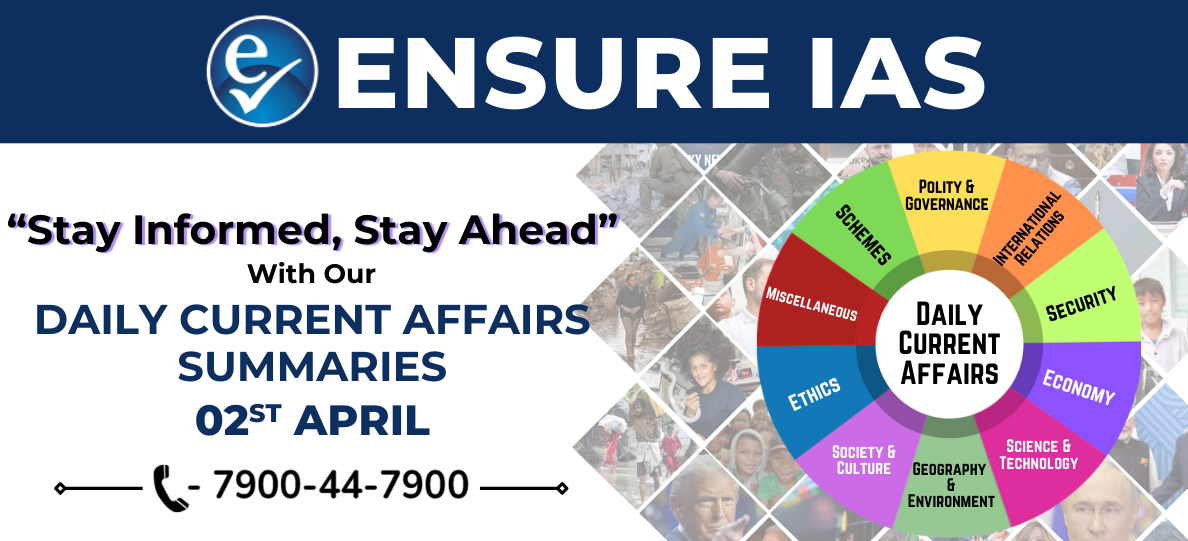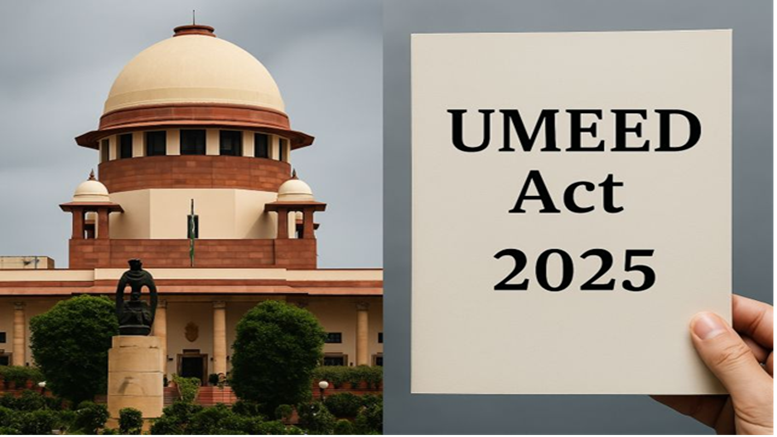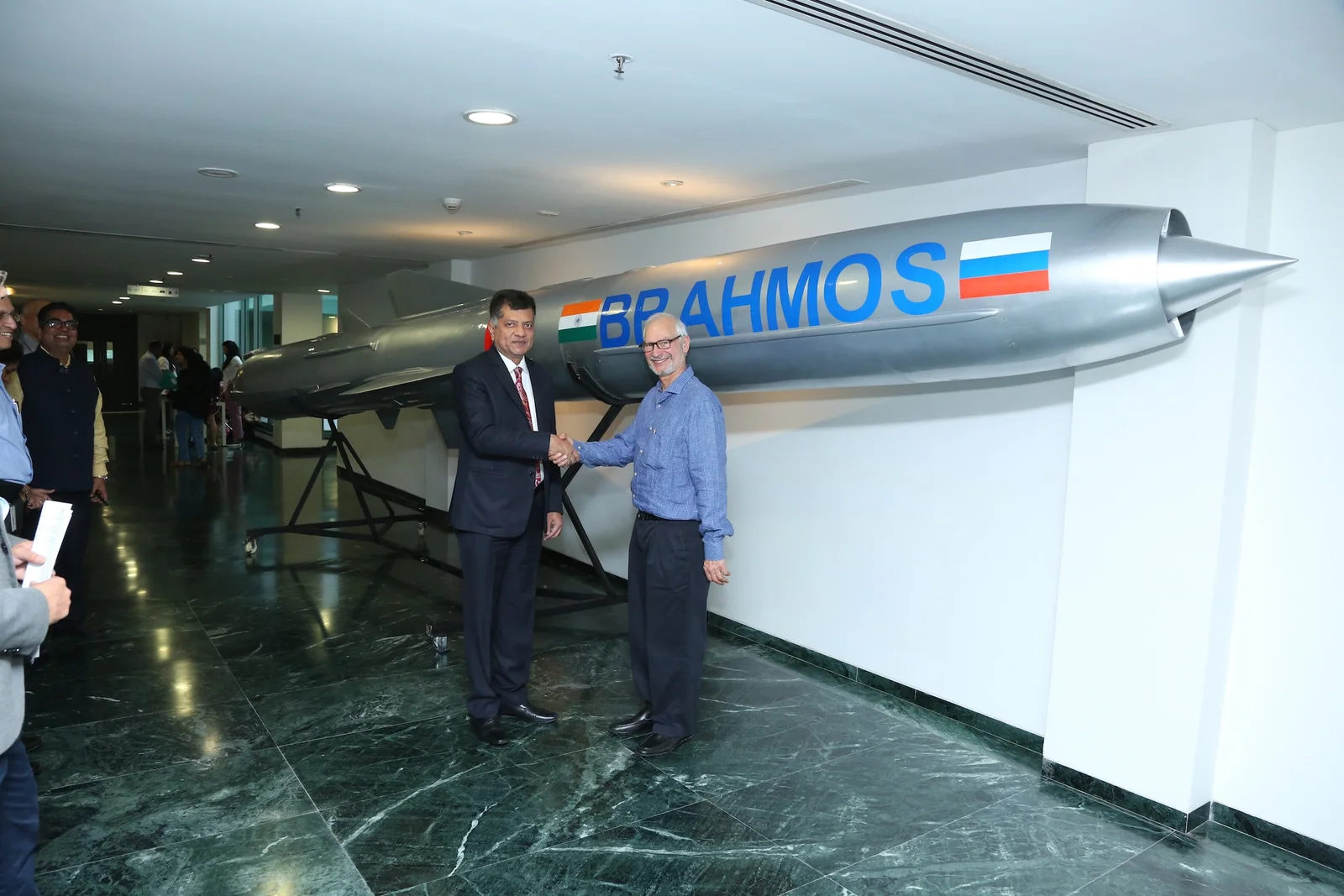- Courses
- GS Full Course 1 Year
- GS Full Course 2 Year
- GS Full Course 3 Year
- GS Full Course Till Selection
- Online Program
- GS Recorded Course
- NCERT (Recorded 500+ Hours)
- Polity Recorded Course
- Geography Recorded Course
- Economy Recorded Course
- AMAC Recorded Course
- Modern India, Post Independence & World History
- Environment Recoded Course
- Governance Recoded Course
- Science & Tech. Recoded Course
- International Relations and Internal Security Recorded Course
- Disaster Management Module Course
- Ethics Recoded Course
- Essay Recoded Course
- Current Affairs Recoded Course
- CSAT
- 5 LAYERED ARJUNA Mentorship
- Public Administration Optional
- ABOUT US
- OUR TOPPERS
- TEST SERIES
- FREE STUDY MATERIAL
- VIDEOS
- CONTACT US
Daily Current Affairs Summary - 2nd APRIL 2025
Daily Current Affairs Summary - 2nd APRIL 2025

Avalanche Breakdown: Technique for Detecting Radioactive Materials
U.S. physicists have demonstrated an innovative method to detect radioactive materials remotely using carbon-dioxide lasers. This technique relies on a phenomenon known as avalanche breakdown.
Understanding Avalanche Breakdown:
- Radioactive decay releases charged particles, which ionize the surrounding air by separating positive and negative charges, creating plasma.
- Electrons in this ionized state gain energy and collide with nearby atoms, releasing additional electrons in a cascading effect known as avalanche breakdown.
Potential Applications:
- Enhancing security measures, such as scanning shipping containers at ports.
- Supporting emergency response efforts for radioactive material detection.
90 Years of RBI’s First Monetary Policy (1935-2025)
The year 2025 marks the 90th anniversary of the Reserve Bank of India's (RBI) first monetary policy announcement in 1935. Following its establishment, RBI introduced key policy measures, including setting the bank rate (BR) and the cash reserve ratio (CSR), laying the foundation for India's monetary policy framework.
Understanding Monetary Policy
Monetary policy refers to the regulation of money supply and interest rates by a country's central bank to maintain economic stability. In India, RBI formulates and implements monetary policy with the following objectives:
- Ensuring price stability
- Promoting economic growth
- Maintaining financial stability
Must Read: First Repo Rate Cut In 5 Years
Instruments of Monetary Policy
Monetary policy tools are categorized into two types:
1. Quantitative Tools (Affect overall money supply)
- Repo Rate: The rate at which RBI lends to commercial banks.
- Reverse Repo Rate: The rate at which RBI borrows from commercial banks.
- Statutory Liquidity Ratio (SLR): The minimum percentage of a bank’s net demand and time liabilities that must be maintained in liquid assets.
- Marginal Standing Facility (MSF): A window for banks to borrow overnight funds from RBI against approved government securities.
2. Qualitative Tools (Regulate credit flow in specific sectors)
- Moral Suasion: Persuading banks to follow specific credit policies.
- Direct Action: Regulatory actions taken against banks for non-compliance.
Types of Monetary Policy
- Contractionary Monetary Policy: Aims to control inflation by increasing interest rates and reducing the money supply, thereby restricting borrowing and spending.
- Expansionary Monetary Policy: Reduces interest rates and increases liquidity in the economy, encouraging borrowing and investment.
India’s Current Monetary Policy Framework
Prior to 2016, the RBI Governor had sole authority over monetary policy decisions. However, the Finance Act, 2016 amended the RBI Act, 1934, introducing a structured decision-making process through the Monetary Policy Committee (MPC).
|
Monetary Policy Committee (MPC) The MPC plays a crucial role in India's monetary policy formulation under the Flexible Inflation Targeting (FIT) framework. Key Features of MPC:
|
Neuralink’s ‘Blindsight’ Chip: First Human Implant Planned by 2025
Neuralink aims to implant its ‘Blindsight’ chip in a human subject by 2025. The device, designated as a ‘breakthrough’ technology by the U.S. Food and Drug Administration (FDA), is designed to restore vision through advanced brain-computer interface (BCI) technology.
What is Blindsight?
Blindsight is a Brain-Computer Interface (BCI) implant that bypasses the retina and directly stimulates the visual cortex to restore vision.
- The visual cortex, located in the cerebral cortex, is responsible for processing visual information from the eyes.
- The implant consists of a microelectrode array, embedded within the visual cortex, capable of stimulating neurons to interpret visual data.
Must Read: Breakthrough Device” Status To Neuralink's Blindsight
Understanding Brain-Computer Interface (BCI)
A BCI system deciphers brain activity and transmits signals to external software, allowing users to control devices through thought.
Applications of BCI
- Healthcare:
- Diagnosis of neurological disorders.
- Assistive technology for individuals with disabilities.
- Communication & Control:
- Thought-based device control.
- Automated environmental adjustments.
- Commercial Use: Applications in transportation, advertising, and smart technologies.
- Other Sectors: Gaming, entertainment, security authentication, and cognitive enhancement.
Challenges & Concerns
Must Read: Neuralink implants brain chip in first human
Despite its revolutionary potential, BCI technology presents several challenges:
- Usability Limitations: Adoption barriers due to complexity and accessibility.
- Safety Risks: Potential for tissue damage, seizures, and unknown long-term effects.
- Ethical Considerations: Issues surrounding informed consent and data privacy.
Must Read: World’s Most Powerful Mri Scans First Images Of Human Brain
CBDT signed the highest number of Advance Pricing Agreements in a financial Year
In FY 2024-25, Central Board of Direct Taxes (CBDT) signed 174 APAs surpassing 125 APAs of FY 2023-24.
- The Ministry of Finance introduced the provisions of APA under the Finance Act, 2012, by inserting Sections 92CC and 92CD into the Income Tax Act, 1961.
What is Advance Pricing Agreement (APA)?
- An APA is an agreement between the Board (tax authority) and the person (taxpayer).
- It aims to provide certainty to taxpayers in the area of transfer pricing by specifying pricing methods and determining the arm's length price (refer to box) of international transactions.
- The term of APA can be a maximum of 5 years with no minimum period.
|
Key Concepts/Terms
|
Must Read: CBDT Notified Amendments To The Income-Tax Rules: Safe Harbour Rule
Types of Advance Pricing Agreement (APA)
- Unilateral APA: It involves only the tax payer and the tax authority of the country.
- Bilateral APA: It involves the taxpayer and tax authority of the country, as well as an associated enterprise (AE) of the taxpayer in another country.
- Multilateral APA: It involves the tax payer, two or more AEs of tax payers in different foreign countries, tax authority of the country, and the tax authorities of AEs.
Significance of Advance Pricing Agreement
- Reduce the risk of potential double taxation.
- Reduce compliance cost by eliminating the risk of transfer pricing audit, etc.
- Enhance ease of doing business, particularly for multinational enterprises.
50th Anniversary of the Biological Weapons Convention (BWC)
The Biological Weapons Convention (BWC), the first multilateral treaty to prohibit an entire category of Weapons of Mass Destruction (WMD), marked its 50th anniversary. Opened for signature in April 1972, it officially came into force on March 26, 1975.
About the BWC
Formally known as the Convention on the Prohibition of the Development, Production, and Stockpiling of Bacteriological (Biological) and Toxin Weapons and on their Destruction, the BWC aims to eliminate the threat of biological and toxin weapons.
- Nature of Biological and Toxin Weapons
- These include microorganisms such as viruses, bacteria, and fungi, or toxic substances derived from living organisms, deliberately used to cause harm to humans, animals, or plants.
- Examples: Anthrax, Botulinum toxin, and Plague.
- Consequences: Food insecurity, environmental disasters, economic damage, public health crises, and societal unrest.
- Background: Negotiated in Geneva, Switzerland, under the Conference of the Committee on Disarmament.
Must Read: International Day for the Total Elimination of Nuclear Weapons | 26 September
- Key Provisions
- The BWC prohibits the development, production, acquisition, transfer, stockpiling, and use of biological and toxin weapons.
- It strengthens the 1925 Geneva Protocol, which only banned the use of such weapons but not their development or stockpiling.
- Membership
- The convention has 188 States Parties and four Signatory States (Egypt, Haiti, Somalia, and Syria).
- India is a signatory to the BWC.
Must Read: The Ethics of Nuclear Weapons | 2024 Nobel Peace Prize
|
Other International Treaties Prohibiting WMD
(Must Read: Nuclear Non-Proliferation Treaty (NPT) - 55 Years Since Coming Into Force)
|
Self-Amplifying mRNA (saRNA) Vaccine for Nipah Virus
Gennova Biopharmaceuticals is developing an innovative self-amplifying mRNA (saRNA) vaccine candidate targeting the Nipah virus. This initiative is supported by expanded funding from the Coalition for Epidemic Preparedness Innovations (CEPI).
About the Nipah Virus:
- A zoonotic virus from the Paramyxovirus family.
- Fruit bats serve as its natural reservoir.
Understanding saRNA Vaccines:
- Unlike traditional vaccines that introduce antigens directly, mRNA vaccines instruct the body to produce antigenic proteins.
- Self-amplifying mRNA (saRNA) vaccines go a step further by enabling the body to replicate mRNA, generating the required antigen in greater quantities.
- This approach enhances the immune response while requiring lower doses compared to conventional mRNA vaccines.
Trade Watch Quarterly Report: Key Insights
NITI Aayog has released the second edition of the Trade Watch Quarterly, providing a detailed assessment of India’s trade performance. The report presents key trends and shifts in both exports and imports on a quarterly basis.
Key Findings:
- Top Export Destinations: The United States, United Arab Emirates (UAE), and the Netherlands remain India's leading export markets, collectively accounting for 33% of total exports.
- Major Import Sources: China, UAE, and Russia continue to be India's top import partners.
- Global Trade Position: India ranks among the top 10 exporters globally and was the 6th largest textile exporter in 2023, contributing around 4% to global trade.
Exercise Tiger Triumph 2025 Begins
The 4th edition of Exercise Tiger Triumph has commenced along the Visakhapatnam coast. This bilateral tri-service exercise between India and the United States focuses on Humanitarian Assistance and Disaster Relief (HADR) operations.
Key Objectives:
- Strengthening interoperability between Indian and US armed forces for effective HADR operations.
- Developing Standard Operating Procedures (SOPs) for coordinated disaster response.
- Establishing a Combined Coordination Center (CCC) to enhance joint operational planning and execution.
WHO Global Conference on Air Pollution and Health
The Second WHO Global Conference on Air Pollution and Health took place in Cartagena, Colombia, bringing together global stakeholders to address the urgent need for cleaner air and improved public health.
About the Conference:
- Organized by: WHO, Colombia, and UN agencies such as UNEP and WMO.
- Objective: Advancing action on clean air, clean energy access, and climate change mitigation.
Key Highlights:
- Global Commitment: Over 50 countries pledged to reduce the health impacts of air pollution by 50% by 2040.
- India’s Stand: Reaffirmed its dedication to tackling air pollution through measures aligned with the National Clean Air Programme (NCAP).
Bodh Gaya Temple and Ongoing Protests
Buddhist monks are staging protests at the Mahabodhi Mahavihara (Bodh Gaya Temple) in Bihar, demanding the repeal of the Bodh Gaya Temple Act, 1949.
About Bodh Gaya Temple:
- One of the four sacred sites associated with the life of Lord Buddha, particularly his Enlightenment.
- Recognized as a UNESCO World Heritage Site since 2002.
- Originally one of the 84,000 shrines commissioned by Emperor Ashoka in the 3rd century B.C.
- The present temple, dating back to the 5th or 6th century A.D., belongs to the Gupta period and is among the earliest Buddhist temples built entirely of bricks.
- The temple's architecture and significance were documented by Hiuen Tsang, the renowned Chinese pilgrim.
Nankai Trough: Japan’s Megaquake Warning
Japan has issued a warning about a possible megaquake in the Nankai Trough, a region prone to powerful seismic activity.
Understanding Megaquakes:
Also known as megathrust earthquakes, these are highly destructive quakes with a magnitude of 8 or higher.
About Nankai Trough:
- A subduction zone where the Philippine Sea Plate is subducting beneath the Eurasian Plate in the Pacific Ocean.
- Subduction zones are regions where two tectonic plates collide, with one sliding beneath the other.
- Extends 900 km off Japan’s southwest Pacific coast, making it a high-risk zone for major seismic events.
PCA Framework for Urban Co-operative Banks (UCBs)
Starting April 1, 2025, around 500 Primary Urban Co-operative Banks (UCBs) will transition to the Prompt Corrective Action (PCA) Framework under the Reserve Bank of India's (RBI) supervisory framework.
Must Read: What is Prompt Corrective Action (PCA)?
About the PCA Framework:
- Introduced by RBI: Initially implemented for Scheduled Commercial Banks in 2002, the PCA framework was extended to UCBs in July 2024, replacing the Supervisory Action Framework (SAF).
- Objective: Ensures timely supervisory intervention, requiring UCBs to take corrective actions to restore financial stability.
- Applicability: Covers all Tier 2, Tier 3, and Tier 4 UCBs.
- Key Monitoring Areas: Focuses on Capital, Asset Quality, and Profitability to maintain financial discipline.
|
Also Read |
|
| NCERT Books For UPSC | |
| UPSC Monthly Magazine | Best IAS Coaching in Delhi |


![img-PSYCHOLOGICAL WARFARE [PSYWAR]](https://i.filecdn.in/755esias/PSYCHOLOGICALWARFAREPSYWAR-1747206772505.jpg)

